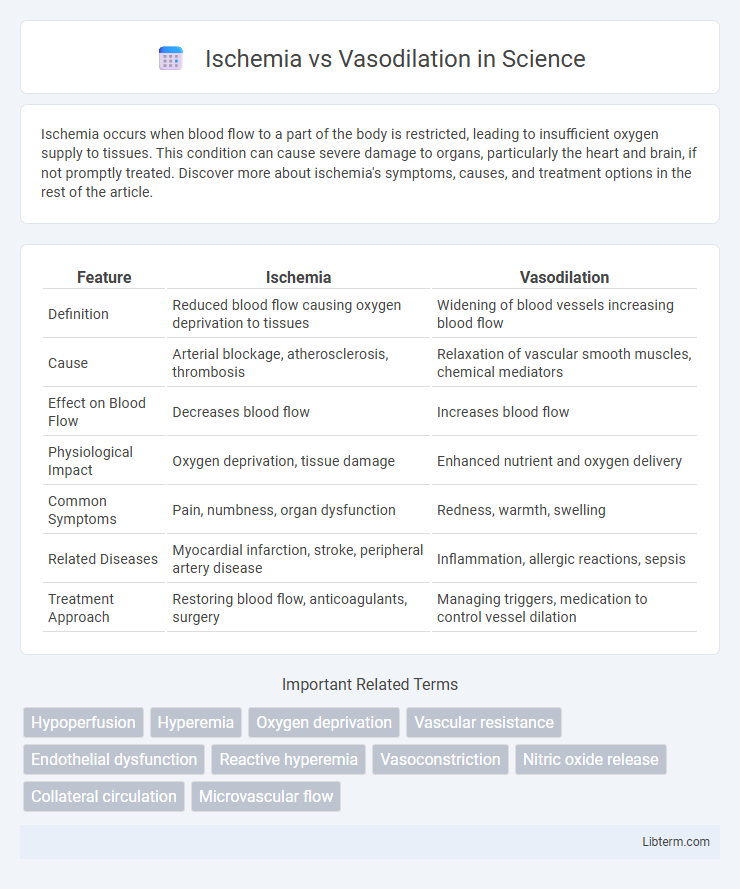Ischemia occurs when blood flow to a part of the body is restricted, leading to insufficient oxygen supply to tissues. This condition can cause severe damage to organs, particularly the heart and brain, if not promptly treated. Discover more about ischemia's symptoms, causes, and treatment options in the rest of the article.
Table of Comparison
| Feature | Ischemia | Vasodilation |
|---|---|---|
| Definition | Reduced blood flow causing oxygen deprivation to tissues | Widening of blood vessels increasing blood flow |
| Cause | Arterial blockage, atherosclerosis, thrombosis | Relaxation of vascular smooth muscles, chemical mediators |
| Effect on Blood Flow | Decreases blood flow | Increases blood flow |
| Physiological Impact | Oxygen deprivation, tissue damage | Enhanced nutrient and oxygen delivery |
| Common Symptoms | Pain, numbness, organ dysfunction | Redness, warmth, swelling |
| Related Diseases | Myocardial infarction, stroke, peripheral artery disease | Inflammation, allergic reactions, sepsis |
| Treatment Approach | Restoring blood flow, anticoagulants, surgery | Managing triggers, medication to control vessel dilation |
Understanding Ischemia: Definition and Causes
Ischemia is a medical condition characterized by the insufficient blood flow to tissues, resulting in a shortage of oxygen and nutrients essential for cellular metabolism. Common causes of ischemia include atherosclerosis, blood clots, and arterial spasms, which impair vascular function and restrict perfusion. Understanding the pathophysiology of ischemia is crucial for diagnosing conditions like myocardial infarction and stroke, where prompt restoration of blood flow is vital to prevent tissue damage.
What is Vasodilation? Mechanisms and Effects
Vasodilation is the process of widening blood vessels resulting from the relaxation of vascular smooth muscle, primarily in the arterial walls. This mechanism is regulated by factors such as nitric oxide release, prostacyclin production, and reduced sympathetic nervous system activity, facilitating increased blood flow and oxygen delivery to tissues. Vasodilation plays a critical role in regulating blood pressure, enhancing nutrient exchange, and counteracting ischemia by improving tissue perfusion.
Key Differences Between Ischemia and Vasodilation
Ischemia refers to the restriction of blood flow to tissues, causing a shortage of oxygen and nutrients, often resulting in tissue damage or necrosis. Vasodilation is the process of widening blood vessels, which increases blood flow and reduces vascular resistance. Key differences include ischemia causing harmful oxygen deprivation, while vasodilation enhances oxygen delivery and can lower blood pressure.
Symptoms of Ischemia vs Vasodilation
Ischemia presents with symptoms such as chest pain, shortness of breath, and fatigue due to reduced blood flow and oxygen supply to tissues. Vasodilation symptoms include warmth, redness, and swelling in the affected area, resulting from the expansion of blood vessels and increased blood flow. Unlike ischemia, vasodilation often leads to decreased blood pressure and a sensation of flushing or heat.
Pathophysiological Pathways: Ischemia and Vasodilation
Ischemia results from impaired blood flow leading to oxygen deprivation, triggering cellular energy failure and accumulation of metabolic waste, which causes tissue hypoxia and damage. Vasodilation involves the relaxation of vascular smooth muscle cells mediated by nitric oxide and other endothelium-derived factors, enhancing blood flow and oxygen delivery to tissues. These opposing pathophysiological pathways regulate tissue perfusion dynamics crucial in conditions like myocardial infarction, stroke, and inflammatory responses.
Diagnostic Approaches: Ischemia vs Vasodilation
Diagnostic approaches for ischemia primarily involve imaging techniques such as stress tests, cardiac MRI, or angiography to identify restricted blood flow in tissues. Vasodilation diagnosis often relies on assessing vascular responses through methods like plethysmography or Doppler ultrasound to measure blood vessel expansion and blood flow changes. Biomarkers and hemodynamic monitoring further aid in differentiating ischemic conditions from vasodilatory states.
Clinical Implications and Consequences
Ischemia results from restricted blood flow causing tissue hypoxia and cellular damage, significantly increasing the risk of myocardial infarction and stroke if untreated. Vasodilation, by contrast, enhances tissue perfusion and oxygen delivery, often employed therapeutically in managing hypertension and peripheral artery disease. Clinical consequences of ischemia include pain, organ dysfunction, and necrosis, whereas vasodilation can lead to hypotension and edema if excessively induced.
Treatment Options: Managing Ischemia and Vasodilation
Treatment options for ischemia primarily focus on restoring adequate blood flow through interventions such as anticoagulants, thrombolytic therapy, and angioplasty to prevent tissue damage. Vasodilation management often involves pharmacological agents like calcium channel blockers, nitrates, or ACE inhibitors to relax blood vessels and improve circulation. Both conditions benefit from lifestyle modifications including exercise, diet changes, and smoking cessation to enhance vascular health and reduce symptoms.
Preventive Strategies for Ischemia and Vasodilation
Preventive strategies for ischemia involve controlling risk factors such as hypertension, diabetes, and hyperlipidemia while promoting regular physical activity and a balanced diet rich in antioxidants to maintain vascular health. Vasodilation prevention focuses on avoiding excessive vasodilator use and managing conditions like hypotension through medication adjustment and hydration to maintain optimal blood flow. Monitoring endothelial function and addressing inflammation through pharmacological agents like ACE inhibitors or calcium channel blockers can significantly reduce ischemic episodes and optimize vasodilatory responses.
Summary: Comparing Ischemia and Vasodilation in Patient Care
Ischemia refers to the restricted blood flow to tissues causing oxygen deprivation and potential cell damage, commonly seen in conditions like coronary artery disease. Vasodilation involves the widening of blood vessels, increasing blood flow and oxygen delivery, often induced by medications such as nitroglycerin or during inflammatory responses. Effective patient care requires distinguishing ischemia's harmful effects from vasodilation's therapeutic benefits to optimize treatment strategies and improve tissue perfusion.
Ischemia Infographic

 libterm.com
libterm.com